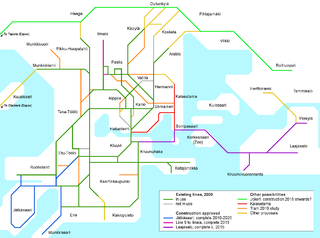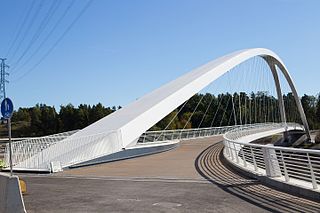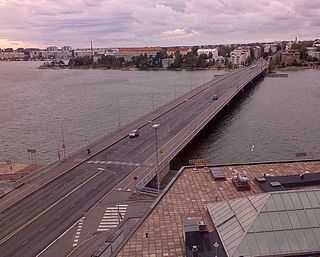
Ruoholahti is a quarter in Helsinki, part of the Länsisatama neighbourhood and Kampinmalmi district. It is located in the southwestern part of the central city area of Helsinki, close to the Lauttasaari island, and it functions as the principal connection between the Helsinki city centre and the city of Espoo to the west. As of 2005 Ruoholahti is inhabited by approx. 3300 people. The Länsisatama port is also situated in Ruoholahti.

Lauttasaari is an island in Helsinki, Finland, about 3 kilometres (1.9 mi) west of the city centre. Together with some surrounding unpopulated small islands, Lauttasaari is also a district of Helsinki. With 23,226 residents as of 2017, the island is Finland's second largest by population, after Fasta Åland. Its land area is 3.85 km2.

The Finnish railway network consists of a total track length of 9,216 km (5,727 mi) of railways built with broad 1,524 mm commonly known as Russian gauge track, of which 3,249 km (2,019 mi) of track is electrified. Passenger trains are operated by the state-owned enterprise VR that runs services on 7,225 km (4,489 mi) of track. These services cover all major cities and many rural areas, though the coverage is less than the coverage provided by the bus services. Most passenger train services originate or terminate at Helsinki Central railway station, and a large proportion of the passenger rail network radiates out of Helsinki. VR also operates freight services. Maintenance and construction of the railway network itself is the responsibility of the Finnish Rail Administration, which is a part of the Finnish Transport Agency. The network consists of six areal centres, that manage the use and maintenance of the routes in co-operation. Cargo yards and large stations may have their own signalling systems.

Länsimetro is an extension to the Helsinki Metro system in Finland. The grand opening for the long-awaited extension was held on 18 November 2017. Länsimetro extends the system's two lines, M1 and M2, from Central Helsinki to the neighbouring city of Espoo. The new stretch continues the lines from the existing Ruoholahti station via the island of Lauttasaari, the Aalto University Otaniemi campus and Tapiola, the terminus of line M2. Line M1 continues further west to Matinkylä. Unlike previous extensions to the Helsinki Metro system, Länsimetro runs entirely underground. The second phase is scheduled to open on December 3, 2022 and will continue the line further west to Kivenlahti, which is located near the municipal border of Kirkkonummi.

The Helsinki tram network forms part of the Helsinki public transport system organised by Helsinki Regional Transport Authority and operated by Metropolitan Area Transport Ltd in the Finnish capital city of Helsinki. The trams are the main means of transport in the city centre. 56.7 million trips were made in 2013. The Helsinki system is one of the oldest electrified tram networks in the world.

Klaukkala is the southern-most urban area of the Nurmijärvi municipality in Uusimaa, Finland, located near Lake Valkjärvi. It is the largest urban area in Nurmijärvi, and despite the fact that it officially has the status of a village, it's often mistakenly thought to be a separate town due to its size and structure. In the 2010s, Klaukkala's urban area grew to be part of the larger Helsinki urban area.

Tampere Central Station is a functionalist building in Tampere, Finland, designed by Eero Seppälä and Otto Flodin, completed in 1936. The station is one of the most important railway stations in Finland. In 2015, the Tampere Central Station was the second busiest railway station in Finland in terms of numbers of passengers, after the Helsinki Central Station.

Niittykumpu (Finnish) or Ängskulla (Swedish) is a district of Espoo, a city in Finland. The districts belongs to the major district of Suur-Tapiola. The district, partly located on the eastern lands of the former Gräsa manor, started developing along with the rest of southern Espoo in the 1930s when the street Jorvaksentie was completed. The first significant construction phase of Niittykumpu happened during the 1960s and 1970s, when a large number of terraced houses were built in the are because of rapid growth of the city of Espoo. Construction slowed down during the early 1990s depression in Finland. Construction picked up pace again in the 2000s and increased even further during the construction of the Länsimetro transport line.

Jätkäsaari is a peninsula and a quarter in Helsinki, the capital city of Finland. It is part to the Kampinmalmi district and Länsisatama neighbourhood. It was the location of the main container harbour in Helsinki until late 2008, when the harbour moved to the new facilities in Vuosaari. The terminal for passenger ferries to Tallinn, Estonia, remains in Länsisatama.

Trams in Finland date from a horse-drawn Turku tramway network, which opened in 1890. Electric tramway traction started in Finland in 1900 with the introduction of electric trams in Helsinki, and the last horse-drawn trams were withdrawn from operation in 1917. Although there were three Finnish tramway networks between 1912 and World War II, by 1972 the number of networks had dwindled to just one, that of Helsinki, which remained Finland's only tramway network for almost 50 years. However, in August 2021, a light rail line was opened to the public in Tampere. There have also been proposals to set up tram or light rail networks in some other cities. As of 2021, the most concrete such plans are in Turku.

The city of Helsinki has plans for a radical expansion of the tram network within the 2021–2035 time horizon, as laid out in the Helsinki City Plan, approved by the City Council in October 2016. Below is a list of confirmed and proposed future expansions of the network. The largest confirmed projects are the 25-kilometre (16 mi) trunk line 550 ("Jokeri") and the 10-kilometre (6.2 mi) connection in the direction of East Helsinki to the island of Laajasalo, which will include the longest bridge in Finland. Together, these two will effectively double the track length of the network.

Kone- ja Siltarakennus Oy is a Finnish former engineering company based in Sörnäinen, Helsinki.

Aktiebolaget Sandvikens Skeppsdocka och Mekaniska Verkstad was a Finnish shipbuilding and engineering company that operated in Helsinki in 1895–1938. The company was set up to continue shipbuilding at Hietalahti shipyard, after its predecessor Helsingfors Skeppsdocka, which operated the yard in 1865–1895, had bankrupted.

Isoisänsilta is a pedestrian and cycling bridge in Helsinki, Finland, opened in June 2016.

Posteljooninpuisto is a French formal garden style park built in the 1930s in central Tampere, Finland, at the corner of Rautatienkatu and Itsenäisyydenkatu. At the corner of the park is the former head post office of Tampere. The park is also internally connected to the Tampere railway station located next to it, which the Finnish Heritage Agency has classified as a significant cultural environment. The park is owned by the city of Tampere.

The Lauttasaari bridge is a bridge in Helsinki, Finland, over the Lauttasaarensalmi strait. The bridge connects the island of Lauttasaari to mainland Helsinki. The mainland end is in Salmisaari in the Ruoholahti district, with the Porkkalankatu street leading to the city centre. In Lauttasaari, the street Lauttasaarentie leads west from the bridge.

Satakunnankatu is an east–west, busy street in the center of Tampere, Finland, which is one of the city's main streets. It starts from the vicinity of Tampere Cathedral on the east side of Tammerkoski, where it separates the Jussinkylä and Kyttälä Districts. The street crosses the rapids along the Satakunta Bridge (Satakunnansilta) and runs on the west side between Finlayson and the Hämeenpuisto park. From there it continues through the Amuri area to the Pirkankatu street.

Sorsapuisto is a refreshment area of 4.2 hectares in Tulli, Tampere, Finland, completed in the 1930s. In 1990 the Tampere Hall was built in the south corner of the park and the whole park was renovated. From 1964 to 1972 the site of the Tampere Hall hosted the Tampere zoo featuring the lions Tam and Pere.
Terveystalo is a Finnish private healthcare company. Terveystalo provides healthcare, work healthcare and hospital care services for private persons, corporations, insurance companies and the public sector in about 100 localities with about 180 locations all over Finland.

Itämerentorni is a high-rise office building located in the district of Ruoholahti in Helsinki, Finland. It is part of the Itämerentorni complex which also includes a lower, curved building at the foot of the tower. The building serves as an office for SITRA and PricewaterhouseCoopers. The building is located near the Länsiväylä highway at the Itämerentori square. The building is 66 metres tall and has 18 floors. The building was completed in 2000 and was designed by architect Pekka Helin. In 2000 the building was awarded the steel building of the year prize.





















